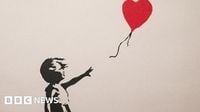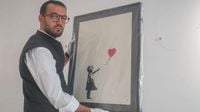The theft of a prized Banksy artwork from a central London gallery in September 2024 has gripped the art world, the courts, and the public alike. The case, now unfolding at Kingston Crown Court, centers on James Love, a builder from North Stifford, Essex, accused of orchestrating the theft of the iconic 'Girl with Balloon' print—valued between £250,000 and £270,000—from the Grove Gallery in Fitzrovia. The print, a limited-edition piece signed by Banksy and authenticated, was part of a two-week exhibition titled "Breakout: Banksy's London Rebellion," showcasing 13 of the elusive artist's works.
According to BBC and other outlets, the story began early on September 8, 2024. James Love, 54 (or 55, as some reports state), was seen making a delivery in his Renault Trafic van, parking just outside the gallery on New Cavendish Street. Prosecutors allege that Love, who had a penchant for artwork featuring love hearts, was within a few feet of the Banksy print that very morning. The connection between Love and the stolen piece seems almost fateful: his home reportedly displayed about four other artworks centered on love hearts, making the 'Girl with Balloon'—with its red heart-shaped balloon—a perfect thematic fit for his collection.
But the events of that September evening were anything but serendipitous. As outlined by prosecutor Philip Stott at Kingston Crown Court and reported by PA Media, BBC, and the Daily Mail, Love wasn't acting alone. At around 11pm, Larry Fraser, 48, smashed through the gallery's glass front door. CCTV footage played in court captured Fraser, hooded, as he grabbed the Banksy print—hanging just by the entrance—and fled. The heist, described as lasting just 37 seconds, was swift and calculated.
Love's alleged role was pivotal. Described as a "relatively successful builder," he is said to have acted as the getaway driver. Phone records and CCTV placed him in the vicinity of the gallery throughout the day and at the time of the theft. The two men exchanged several calls between 12:51pm and 3:44pm, and again just before and after the theft. Notably, Love transferred £200 to Fraser on the day of the crime—a significant sum compared to the mere £1.75 Fraser reportedly had in his bank account the day before. Prosecutors highlighted this financial disparity, suggesting a transactional relationship: Love had previously paid Fraser small amounts, usually £20, about 20 times in the preceding year, but the £200 transfer on the day of the theft stood out.
After the heist, the duo didn't immediately retreat to safety. Instead, Fraser took the print to a nearby property, leaving it in a hallway and changing his top—a detail confirmed by the startled night watchman, Sukhinder Singh. Singh testified that he discovered a "large painting" by an interior doorway, having "no idea how it had got there because it hadn't been there when he walked past the same spot earlier that evening." Moments later, Singh saw a white plastic object coming through the lock of the front door. Opening it, he was confronted by two men—one white, one black—who pushed past him, collected the artwork, and left. Prosecutors identified these men as Love and Fraser.
The next steps in the caper were equally deliberate. Love and Fraser walked away with the Banksy, stashing it temporarily before retrieving it and placing it in the back of Love's van. They then drove to a block of flats on the Isle of Dogs, where Love unloaded the artwork. The Metropolitan Police’s Flying Squad, acting on information provided by Love after his arrest on September 10, 2024, later recovered the print from a ground-floor cupboard under a dust sheet at this location. Love, while at magistrates’ court for his first appearance, reportedly produced a hand-drawn plan to guide officers to the hidden artwork. As prosecutor Stott remarked in court, "Given that it’s worth £270,000 at least, we won’t exhibit it, we will return it at the end of the day."
The case against Love hinges not just on the sequence of events but on motive. Prosecutors argue that Love's desire to add the Banksy to his personal collection of heart-themed artwork was the driving force behind the theft. As Stott told jurors, "Given that it was Mr Love who had multiple pieces of art based on love hearts already on his walls, it was likely stolen with a view to it eventually, when the heat had died down, ending up in the same place." This theory is bolstered by the fact that Fraser, during the burglary, went straight for the 'Girl with Balloon' print—ignoring other valuable pieces in the gallery and not targeting the original Banksy inside. The prosecution asserts that the theft was premeditated, with Love orchestrating the operation and Fraser carrying out the physical act.
Fraser has already pleaded guilty to burglary, admitting his role in the high-profile theft. Love, however, maintains his innocence, denying the charge of burglary. His defense, as outlined in court, is that he did not commit the burglary and that the prosecution must prove beyond doubt that he was complicit in the theft and intended to permanently deprive the owner of the artwork.
The trial, ongoing as of September 15, 2025, has captivated observers, not least because of the value and notoriety of the stolen artwork. The 'Girl with Balloon' print, with its spray-stencil image of a young girl reaching for a red heart-shaped balloon, is one of Banksy's most recognized and beloved images. The theft occurred just a day after the conclusion of the gallery's Banksy exhibition, adding to the drama and sense of loss within the art community.
The case has also raised questions about art security, the allure of high-value works, and the personal motivations that drive individuals to risk everything for a piece of cultural history. As the trial continues, the art world watches closely, eager to see whether the jury will be convinced by the prosecution's narrative of a collector driven by obsession, or by the defense's insistence on Love's innocence.
Adding a twist to the ongoing fascination with Banksy's work, earlier this month saw the removal of a new Banksy mural from the Royal Courts of Justice in London. The mural depicted a protester lying on the ground with a blood-spattered placard, while a judge in full regalia loomed over him—a stark reminder of the artist's enduring ability to provoke and challenge through art.
The fate of James Love now rests with the court, but the saga of the stolen Banksy has already left an indelible mark on London's art scene and on those who follow the mysterious world of Banksy.


